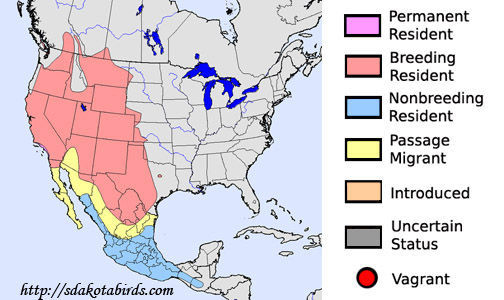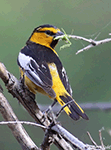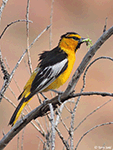Bullock's Oriole
Icterus bullockii
| Length: 7 to 8 inches | Wingspan: 11 to 12 inches | Seasonality: Summer |
| ID Keys: Black cap and throat, orange face, prominent white wing patch | ||
 This bird was formerly
considered to belong to the same species as the more eastern Baltimore
Oriole, under the combined name of "Northern Oriole". The
Bullock's Oriole is the "western" species, found in the western half of the
continent, while the Baltimore Oriole is found in the East. Many South
Dakota birds are variously intermediate between the two extremes, as the two
species interbreed where their ranges come into contact. They were originally
named after William Bullock, an English naturalist who helped identify the
species.
This bird was formerly
considered to belong to the same species as the more eastern Baltimore
Oriole, under the combined name of "Northern Oriole". The
Bullock's Oriole is the "western" species, found in the western half of the
continent, while the Baltimore Oriole is found in the East. Many South
Dakota birds are variously intermediate between the two extremes, as the two
species interbreed where their ranges come into contact. They were originally
named after William Bullock, an English naturalist who helped identify the
species.
Habitat:
Areas of forest edge or open forest, such as woodlands, shelter belts, isolated tree groves, or residential areas.
Diet:
Primarily feeds on insects during the summer months. Will also eat berries and fruits.
Behavior:
Forages by climbing and flitting through the foliage and branches of trees and shrubs, gleaning insects from vegetation surfaces, as well as flying out to capture nearby insects in mid-air.
Nesting:
June and July in South Dakota. The nest is a large hanging pouch, built of grasses, weed stems, and other long material that can be woven into the nest structure. The female usually lays 4 or 5 eggs, and she alone incubates them. Once the eggs hatch, both parents help to feed the nestlings. The young leave the nest about 2 weeks after hatching.
Song:
Short series of nasal whistled notes, interspersed with harsher cackling notes. The call is a simple sharp, one-note calll, while they also have a harsher scolding call given when disturbed or threatened.
1Click here to hear the short call notes and whistles of a Bullock's Oriole
2Click here to hear the song of a male Bullock's Oriole
Migration:
Neotropical migrant. Summers throughout most of the western United States, summers in Mexico and points south.
Interactive eBird Map:
Click to access an interactive eBird map of Bullock's Oriole sightings
Similar Species:
The most similar species is the Baltimore Oriole. Click here to see a comparison between the two. For basic ID keys between Bullock's Oriole and multiple oriole species, see below:
- Baltimore Oriole. The head of a (male) Baltimore Oriole is completely black, while the Bullock's Oriole has a black cap and throat and a black eyeline on an orange face. Male Baltimore Orioles have orange bars on the top of the wing, compared to a broad white patch on a Bullock's Oriole. Females are much more difficult to tell apart. In general, Bullock's Oriole females are slightly less colorful than female Baltimore Orioles, with a bit more gray tones on the flanks and throat. The edging on the primary and secondary flight feathers is more distinct on a Baltimore Oriole than a Bullock's Oriole. In the field, however, it can be extremely difficulty to identify the two species (female).
- Hooded Oriole. A species of the Southwestern United States, not likely to be seen in South Dakota. Where their ranges do overlap, Hooded Orioles are the species most likely to be confused with a Bullock's Oriole. The head patterns are different, as Hooded Oriole (males) have an orange head with a black throat and front of the face. Male Bullock's Orioles have an orange head overall with a black throat, but have a black cap and a black eye line. Female Hooded Orioles are slightly more colorful than female Bullock's Orioles, with more of a consistent orangish-yellow tone on the underparts compared to a female Bullock's Oriole, which may have gray on the flanks.
- Orchard Oriole. A bird that may overlap in range with the Bullock's Oriole in far western South Dakota, male Orchard Orioles are easily differentiated from male Bullock's Orioles, given the darker reddish tones on an Orchard Oriole. Females can be difficult to tell apart. Size is one clue, as Orchard Orioles are smaller than Bullock's Orioles. Overall, Orchard Orioles appear more of a greenish-yellow, compared to yellowish-orange tones on a Bullock's Oriole. Female Orchard Orioles also have more consistent coloring on the underparts, while female Bullock's Orioles may typically have gray flanks.
Bird Feeders:
Will attend feeders for oranges and other fruit, as well as nectar.
Conservation Status:
Bullock's Orioles are found across a wide geographic area, are common in parts of their range, and overall population trends appear to be stable. The IUCN lists the Bullock's Oriole as a species of "Least Concern".
Further Information:
2) WhatBird - Bullock's Oriole
3) Audubon Guide - Bullock's Oriole
Photo Information:
June 15th, 2018 - Grand County, Utah - Terry Sohl
Audio File Credits
1Richard Webster. Recorded near Portal, Arizona on June 9th, 2015. Original recording and information from xeno-canto.
2Paul Marvin. Recorded in Zapata, Texas on April 10th, 2012. Original recording and information from xeno-canto.
| Click on the map below for a higher-resolution view |
 |
| South Dakota Status: Uncommon summer resident in the far western part of the state, less common elsewhere in the west. |
Additional Bullock's Oriole Photos
Click for a higher-resolution view, or click above for a page devoted to Bullock's Oriole photos


